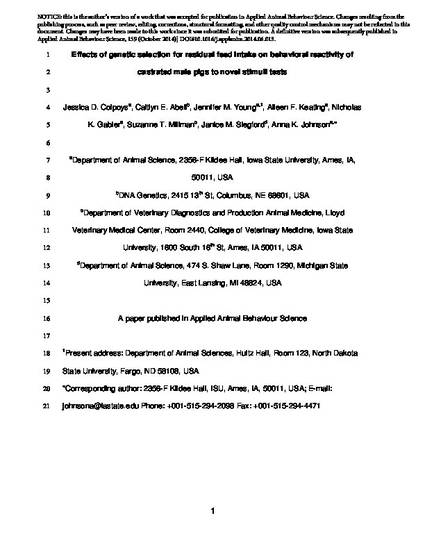
Increasing feed efficiency in swine is important for increasing sustainable food production and profitability for producers; therefore, this is often selected for at breeding. Residual feed intake (RFI) can be used for the genetic selection of pigs for feed efficiency. In our selection project, low-RFI pigs consume less feed for equal weight gain compared to their less efficient, high-RFI counterparts. However, little is known about how feed efficiency influences the pig's behavioral reactivity toward fear-eliciting stimuli. In this study, behavioral reactivity of pigs divergently selected for RFI was evaluated using human approach- (HAT) and novel object tests (NOT). Forty low-RFI (more feed efficient) and 40 high-RFI (less feed efficient) castrated male pigs (barrows; 46.5 ± 8.6 kg) from 8th generation Yorkshire RFI selection lines were randomly selected and evaluated once using HAT and once using NOT over a four week period utilizing a crossover experimental design. Each pig was individually tested within a 4.9 × 2.4 m test arena for 10 min; behavior was evaluated using live and video observations. The test arena floor was divided into four zones; zone 1 being oral, nasal, and/or facial contact with the human (HAT) or orange traffic cone (NOT) and zone 4 being furthest from the human or cone and included the point where the pig entered the arena. During both HAT and NOT, low-RFI pigs crossed fewer zones (P < 0.0001), had fewer head movements (P ≤ 0.02), defecated less frequently (P ≤ 0.03), displayed a shorter duration of freezing (P = 0.05), and froze less frequently (HAT: low-RFI = 4.9 ± 0.65 vs. high-RFI = 7.5 ± 0.96; NOT: low-RFI = 4.7 ± 0.66 vs. high-RFI = 7.2 ± 0.96; P < 0.0001) compared to high-RFI pigs. During HAT, low-RFI pigs also attempted to escape less frequently (low-RFI = 0.4 ± 0.14 vs. high-RFI = 1.1 ± 0.30; P = 0.001) compared to high-RFI pigs. In contrast, compared to the high-RFI pigs, low-RFI pigs took 48 s longer during HAT and 52 s longer during NOT to approach zone 1 (P ≤ 0.04). These results indicate that low-RFI pigs had decreased behavioral reactivity during HAT and NOT compared to high-RFI pigs. This may suggest that reducing a pig's behavioral reactivity is an important component of improving feed efficiency; however, it may have implications for animal handling and facility design.
Available at: http://works.bepress.com/aileen-keating/4/

This is the author’s version of a work that was accepted for publication in Applied Animal Behaviour Science. Changes resulting from the publishing process, such as peer review, editing, corrections, structural formatting, and other quality control mechanisms may not be reflected in this document. Changes may have been made to this work since it was submitted for publication. A definitive version was subsequently published in Applied Animal Behaviour Science, 159 (October 2014)] DOI#10.1016/j.applanim.2014.06.013.